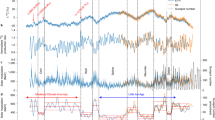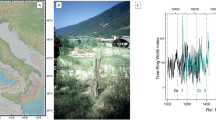Abstract
Results of highly accurate measurements of the radiocarbon concentration in the annual growth rings of trees over the last 400 years are presented. The temporal behavior of the intensity of galactic cosmic rays is reconstructed for the first time for the periods before, during, and after a deep and extended solar activity minimum — the Maunder minimum (1645–1715). It was established that even during the epoch of a deep solar minimum, the intensity of the galactic cosmic rays experienced solar modulation. The time profile of the generation of high-energy gamma radiation from the supernova explosion of 1006 is established. It is shown that processes of particle acceleration and generation of high-energy gamma rays take place with a three-year delay relative to the onset of the optical flare. The time profile of the generation of solar cosmic rays was obtained for the first time over the last thirty cycles of solar activity by precision measurements of the nitrate content in the polar ice cap. It is shown that solar flares accompanied by the generation of cosmic rays occur during the growth and decay phase of solar activity (measured by the Wolf numbers). Research prospects in the field of experimental paleoastrophysics are discussed.
Similar content being viewed by others
References
B. P. Konstantinov and G. E. Kocharov, Dokl. Akad. Nauk 165, 63 (1965).
B. P. Konstantinov and G. E. Kocharov, Preprint No. 64 [in Russian], Physicotechnical Institute, Academy of Sciences of the USSR, Leningrad (1967), 54 pp.
K. Wolfsberg and G. E. Kocharov, in The Sun in Time, edited by C. P. Sonett, M. S. Giampapa, and M. S. Matthews (Tucson 1991), pp. 288–313.
S. Cecchini, M. Galli, T. Nanni, and L. Ruggiero, Nuovo Cimento C 19, 527 (1996).
R. C. Reedy and K. Marti, in The Sun in Time, edited by C. P. Sonett, M. S. Giampapa, and M. S. Matthews (Tucson 1991), pp. 260–287.
G. E. Kocharov, Izv. Ross. Akad. Nauk, Ser. Fiz. 60(8), 112 (1996).
G. E. Kosharov, V. M. Ostryakov, As. N. Peristykh, and V. A. Vasiliev, Sol. Phys. 159, 381 (1995).
G. E. Kocharov and M. G. Ogurtsov, Contemporary Problems in Solar Cyclicity [in Russian], GAO, St. Petersburg (1997).
V. L. Ginzburg, Usp. Fiz. Nauk 166(2), 169 (1996).
G. E. Kocharov, Nuovo Cimento C 19, 883 (1996).
P. Damon, D. Kaimei, G. Kocharov et al., Radiocarbon 37, 599 (1995).
G. E. Kocharov, in Proceedings of the 12th Leningrad Seminar on Cosmic Physics [in Russian], Physicotechnical Institute, Russian Academy of Sciences (1982), pp. 203–207.
Author information
Authors and Affiliations
Additional information
Zh. Tekh. Fiz. 69, 90–93 (September 1999)
Rights and permissions
About this article
Cite this article
Kocharov, G.E. Paleoastrophysics: Progress and prospects. Tech. Phys. 44, 1081–1083 (1999). https://doi.org/10.1134/1.1259476
Received:
Issue Date:
DOI: https://doi.org/10.1134/1.1259476




